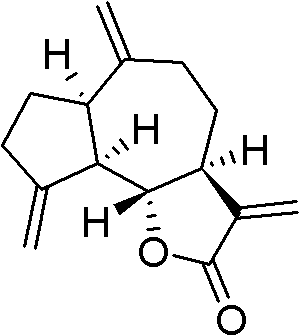Method for preparing high-purity costuslactone and dehydrocostus lactone
A technology of dehydrocorylides and corylides, applied in the direction of organic chemistry, can solve the problems of large solvent consumption, low distribution efficiency, sample adsorption, etc., achieve large separation volume, save solvent, and ease the separation environment Effect
- Summary
- Abstract
- Description
- Claims
- Application Information
AI Technical Summary
Problems solved by technology
Method used
Image
Examples
Embodiment 1
[0032] The methyl acetate-n-propanol-ethanol-water system was selected on a semi-preparative countercurrent chromatograph to separate and purify corylides. The suitable temperature for the experiment is 25°C. Firstly, the above-mentioned solvent components are distributed and placed in a separatory funnel according to the volume ratio of 4:0.8:2:6, shaken and allowed to stand for stratification. After equilibrating for a period of time, separate the upper and lower phases. A semi-preparative countercurrent chromatograph is used, equipped with a polytetrafluoroethylene column, a 20ml injection valve, a column volume of 300ml, a TBP-50A pump, a TBD-23 detector and an N2000 chromatographic workstation. Weigh 100 mg of crude woody sample and dissolve it in a solution composed of 10 ml upper phase and 10 ml lower phase solution for use. Before sample injection, fill the entire column with stationary phase, adjust the speed of the main engine to 950rpm, and pump the mobile phase in...
Embodiment 2
[0034] Select ethyl acetate-n-butanol-ethanol-water system on a semi-preparative countercurrent chromatograph to separate and purify corylides. The suitable temperature for the experiment is 30°C. Firstly, the above-mentioned solvent components are distributed and placed in a separatory funnel according to the volume ratio of 3:0.5:1:8, shaken and then allowed to stand for stratification. After equilibrating for a period of time, separate the upper and lower phases. A semi-preparative countercurrent chromatograph is used, equipped with a polytetrafluoroethylene column, a 20ml injection valve, a column volume of 300ml, a TBP-50A pump, a TBD-23 detector and an N2000 chromatographic workstation. Weigh 150mg of crude woody sample and dissolve in 10ml upper phase and 10ml lower phase solution for use. Before sample injection, fill the entire column with stationary phase, adjust the speed of the main engine to 650rpm, and pump the mobile phase into the column at a flow rate of 3.0m...
Embodiment 3
[0036]Select butyl acetate-n-propanol-ethanol-water system on a semi-preparative countercurrent chromatograph to separate and purify corylides. The suitable temperature for the experiment is 22°C. Firstly, the above-mentioned solvent components are distributed in a separatory funnel according to the volume ratio of 4:1:1:6, shaken and allowed to stand to separate into layers. After equilibrating for a period of time, separate the upper and lower phases. A semi-preparative countercurrent chromatograph is used, equipped with a polytetrafluoroethylene column, a 20ml injection valve, a column volume of 300ml, a TBP-50A pump, a TBD-23 detector and an N2000 chromatographic workstation. Weigh 150mg of crude woody sample and dissolve in 10ml upper phase and 10ml lower phase solution for use. Before sample injection, fill the entire column with stationary phase, adjust the speed of the main engine to 750rpm, and pump the mobile phase into the column at a flow rate of 4.0ml / min; The u...
PUM
 Login to View More
Login to View More Abstract
Description
Claims
Application Information
 Login to View More
Login to View More - R&D
- Intellectual Property
- Life Sciences
- Materials
- Tech Scout
- Unparalleled Data Quality
- Higher Quality Content
- 60% Fewer Hallucinations
Browse by: Latest US Patents, China's latest patents, Technical Efficacy Thesaurus, Application Domain, Technology Topic, Popular Technical Reports.
© 2025 PatSnap. All rights reserved.Legal|Privacy policy|Modern Slavery Act Transparency Statement|Sitemap|About US| Contact US: help@patsnap.com


